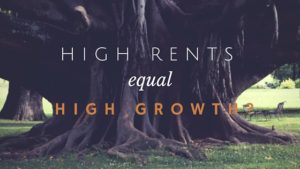 High rent return can mean an undervalued property!
High rent return can mean an undervalued property!
I was chatting to someone recently about their next investment property purchase. They had success in local areas they knew very well and proceeded to ask me about one certain suburb they were looking to buy in once again.
The comment made to me was, “The rents in this suburb I am looking at, have had a kick along this past year, and the yields seem really good now”.
I asked them if it was rental returns or growth as the focus of this investment. They said it was a long term investment and growth was the goal, so this would dismiss the suburb from their list?
No, it does not!
To answer that question you need to know the history of a suburb and the overall rental return expressed as a percentage, normally achieved in that suburb. (This is called Yield Long Term Average or YLTA.)
This suburb, south of Brisbane, had an YLTA of 5.2% rental return. At that present time the rents were pushing almost 6%. I mentioned to my client that this will most likely be an indicator of underpriced property.
Let’s look at how that works.
A standard 3 bed room house in this suburb was renting for about $340 – $360 per week. The houses were usually small or older and in an average condition. Think original outer suburb now on the cusp of being consumed by city growth in the years to come.
The sale prices in this area were sitting between $295,000 and $315,000. If I used the average rental (which is $340-360) and the higher price of $315,000, the average rental return was 5.8%.
Let’s make the assumption the rents had peaked and was no more growth to be had in the short term. Without getting into how this may attract investors and then eat up supply, we will assume that the market will move back to its long term average of a 5.2% rental return.
When this happens, and rents do not change (go up or down), the sale price figures will be:
Rent/week Price
Current – 5.8% rental yield, $350 weekly rent, $315,000 property price.
Future – 5.2% rental yield, $350 weekly rent, $350,000 property price.
As demonstrated by the table above, when the yields return to the long term average in the suburb, and they almost always do, then you will achieve a growth of about $35,000 in this example.
To put it another way, the rental yield being 0.6% above YLTA meant a growth of 11% in the property value when it returns to YLTA.
Please understand that a higher yield does not automatically mean a more capital growth!
However a higher than normal yield in an area, may mean rents have moved and prices will follow.
A movement in the rents like this is part of the property cycle and one of the indicators of the beginning of a rise in prices in that particular area. It is also an early indicator in the 18.5 year property clock that we are in the early stages of the overall cycle.
If you know of a suburb like this and know it well, do your own calculations on the current rental yield and property prices, verses a return to the long term rental average.
You might just find a winner!
Happy Investing
Scott Northcott
P.S. – This is our final chapter in our miniseries on Rental Yield. We will be starting a new series on property fundamentals next.
Since 2004 Scott Northcott has been helping people buy the best properties for their needs at prices that simply speak for themselves.
Scott has been instrumental in bridging the gap between financial planning and traditional real estate transactions through his property advice model. By carefully considering his clients’ goals and planning for market changes via demographics and trends, Scott designs a future proof outcome not only specific to the client’s needs but dynamic in its execution with performance indicators and exit strategies built in.

